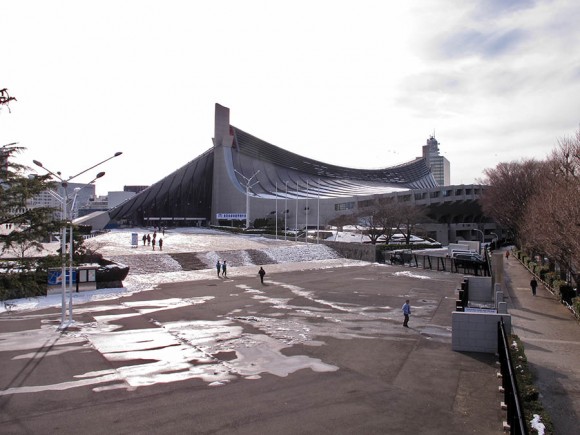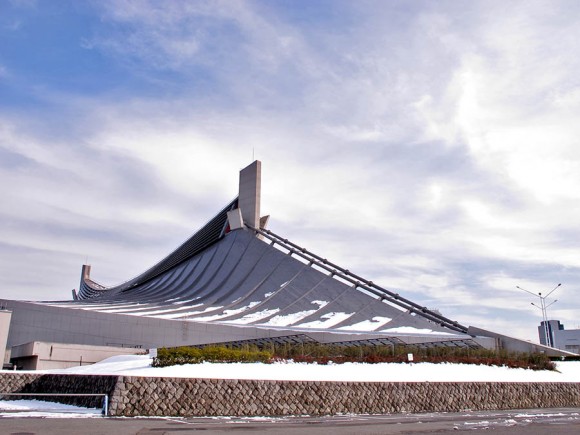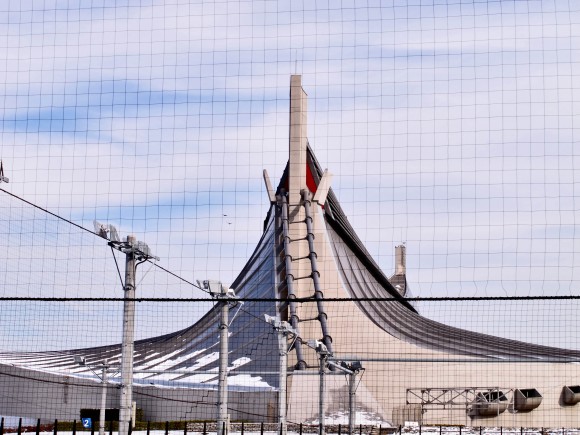The Tokyo Summer Olympics 1964 were a milestone for Japan and the world: for the first time, the Games were held outside the Western world. Risen from the ashes and the pariahdom of WWII, Japan had now officially been readmitted to the international stage. The Yoyogi National Gymnasium in Yoyogi Park near Shibuya was Kenzo Tange’s architectural contribution to the event. Today, the two stadiums stand out as some of Tokyo’s most famous and acclaimed buildings.
Although Japan had already joined the United Nations and the Bretton Woods institutions by 1964, none of these matched the appeal and visibility of hosting the world for the Olympic Games. An unprecedented building frenzy accompanied the run-up to the opening ceremony: train lines and roads were finished, Haneda airport extended and hotels such as the Hotel Okura opened in time for them to host foreign guests.
Construction works on the two stadiums in Yoyogi Park commenced in 1961. Kenzo Tange had by then already designed the Peace Memorial Park and its buildings in Hiroshima as well as several government offices in Tokyo and Kagawa. His buildings for the Olympics as well as St. Mary’s Cathedral (also finished in 1964) were arguably the high point of Tange’s long career.
The then biggest suspended roof structure in the world was achieved using a pair of sagging steel cables hung from two concrete columns about 120 meters apart. For many, the outcome signified the perfect synthesis between traditional and light Japanese wooden structures and the advances of modern technology; a symbol of the Japanese economic miracle unfolding at the very time the Games were held.
The theme of the Games was “Japan as a technology leader”, with Shinkansen trains and a new Japanese passenger aircraft transporting athletes and spectators to Tokyo from across the country. The events were broadcast live across the globe using satellite technology. Timing devices as well as the famous “photo finish” were first used in Tokyo in 1964 and have become indispensable since. You can read much more on the Games in this great essay here.
The large stadium in Yoyogi Park was used as the swimming venue and seated about 15,000 spectators. The smaller structure was used for basketball and gave room for about 5,000 people. ArchDaily has more details on the building along with some great b/w model sketches and interior shots that bring across the unique structural design of the two buildings.
Tange himself lamented the lack of public infrastructure around the stadium complex according to Hiroshi Watanabe’s architecture guide. Access from central Tokyo is possible mainly across a windy pedestrian bridge from Harajuku/Meiji-Jingumae stations.
Tokyo Olympiad by Kon Ichikawa was released to critical acclaim in 1965 and is considered one of the best documentary films of all times. You can watch a bit more than the first half on Youtube or below. The film features amazing footage from the flame lighting ceremony, international delegations arriving in Tokyo as well as most of the sports competitions.
In more current developments, Tokyo has submitted its bid to host the Olympic Games in 2020. The campaign has met with some controversy as many feel Japan should focus on rebuilding the areas devastated by the 2011 tsunami. Others feel that there’s too little domestic support, too high radiation readings and the ever-looming danger of earthquakes. Lastly, growing regional tensions could cost Tokyo important votes. At any rate, we’ll find out in September this year, when the decision will be announced in Buenos Aires. Tokyo is running against Istanbul and Madrid.






